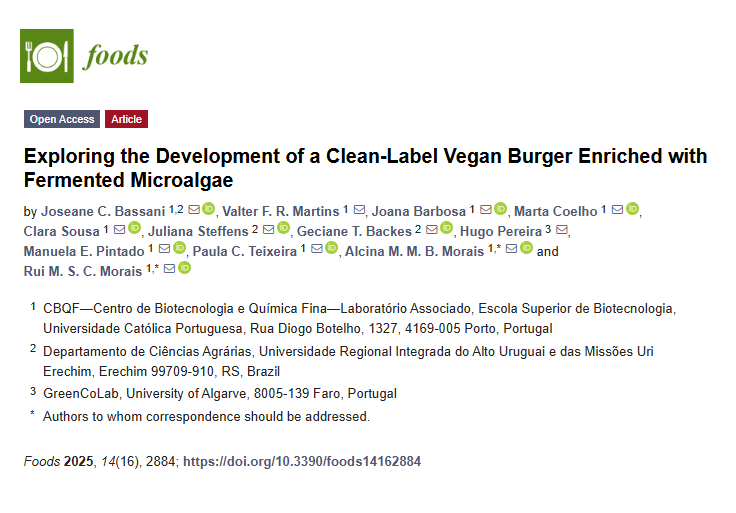

TITLE
Exploring the Development of a Clean-Label Vegan Burger Enriched with Fermented Microalgae
JOURNAL
Foods
AUTHORS
Joseane C. Bassani, Valter F. R. Martins,Joana Barbosa, Marta Coelho, Clara Sousa, Juliana Steffens, Geciane T. Backes, Hugo Pereira, Manuela E. Pintado, Paula C. Teixeira, Alcina M. M. B. Morais, Rui M. S. C. Morais
ABSTRACT
Haematococcus pluvialis and Porphyridium cruentum are red microalgae with high biotechnological potential due to their rich composition of bioactive compounds. However, their intense flavor limits their application in food products. This study evaluated the impact of fermentation with Lactiplantibacillus plantarum (30 °C for 48 h; LAB-to-biomass ratio of 0.1:1; 106 CFU/mL) on the physicochemical and functional properties of H. pluvialis and P. cruentum biomasses. Particular attention was given to antioxidant activity (ABTS and ORAC assays), color, amino acid profiles, and volatile organic compound (VOC) profiles, all of which may influence sensory characteristics. Results demonstrated that non-fermented H. pluvialis exhibited significantly higher antioxidant activity (AA) than P. cruentum. After fermentation, H. pluvialis showed an ABTS value of 3.22 ± 0.35 and an ORAC value of 54.32 ± 1.79 µmol TE/100 mg DW, while P. cruentum showed an ABTS of 0.26 ± 0.00 and an ORAC of 3.11 ± 0.13 µmol TE/100 mg DW. Total phenolic content (TPC) of fermented H. pluvialis and P. cruentum was 1.08 ± 0.23 and 0.18 ± 0.026 mg GAE/100 mg DW, respectively. Both AA and TPC increased after fermentation. Fermentation also significantly affected biomass color. FTIR analysis showed intensification of protein and carbohydrate vibrational bands post-fermentation. GC-MS analysis of VOCs showed that P. cruentum contained 42 VOCs before fermentation, including trans-β-ionone, 4-ethyl-6-hepten-3-one, hexanal, and heptadienal, which are responsible for fishy and algal odors. Fermentation with Lb. plantarum significantly reduced these compounds, lowering trans-β-ionone to 0.1453 mg/L and eliminating 4-ethyl-6-hepten-3-one entirely. H. pluvialis contained 22 VOCs pre-fermentation; fermentation eliminated hexanal and reduced heptadienal to 0.1747 ± 0.0323 mg/L. These changes contributed to improved sensory profiles. Fermentation also induced significant changes in the amino acid profiles of both microalgae. The fermented biomasses were incorporated into vegan burgers made from chickpea, lentil, and quinoa. Color evaluation showed more stable and visually appealing tones, while texture remained within desirable consumer parameters. These findings suggest that Lb. plantarum fermentation is an effective strategy for improving the sensory and functional characteristics of microalgal biomass, promoting their use as sustainable, value-added ingredients in innovative plant-based foods.
Back to Publications



